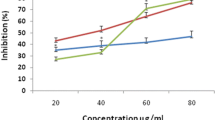Abstract
Oxidative stress imposed by increased concentration of free radicals, particularly, Reactive Oxygen Species (ROS) has been known to contribute to the initiation and progression of several diseases. Plant derived antioxidants can counteract oxidative stress and are capable of reducing the risk of developing these diseases. In the present study, the methanolic extracts of five medicinal plants were tested for their antioxidant capacities using different antioxidant assays. The total flavonoid and phenolic contents of the extracts were determined and a correlation was established between antioxidant capacities and total phenol/flavonoid content. Among the tested extracts, the highest amount of total phenolic and total flavonoid content was found in methanol extract of KUPS_1(Rheum australe) with TPC value of 249.58 ± 7.73 Gallic acid equivalent µg/mg and TFC value of 480.84 ± 8.81 Rutin equivalent µg/mg. All the samples showed 2,2-diphenyl-1-picrylhydrazyl (DPPH), 2,2-azino-bis-(3-ethylbenzothiazoline-6-sulphonic acid) (ABTS) and Ferric Reducing Activity Potential (FRAP) antioxidant activities at different levels. Highest DPPH radical scavenging was shown by KUPS_1(Rheum australe) (IC50 = 3.47 ± 0.09), ABTS radical were most efficiently quenched by KUPS_5(Bergenia ciliata) (IC50 = 3.82 ± 0.63) and the highest reducing potential was shown by KUPS_2(Nirbikhi) (FRAP = 61.76 ± 2.29 equivalent µg Fe2+/ml). A significant correlation was found between the antioxidant activity of extracts and their total phenolic and total flavonoid contents.


Similar content being viewed by others
References
Ahmed D, Khan MM, Saeed R (2015) Comparative analysis of phenolics, flavonoids, and antioxidant and antibacterial potential of methanolic, hexanic and aqueous extracts from adiantum caudatum leaves. Antioxidants 4:394–409
Bajracharya G, Maharjan R (2013) Cytotoxicity, total phenolic content and antioxidant activity of bergenia purpurascens rhizome. Nepal J Sci Technol 14:87–94
Calabrese V, Lodi R, Tonon C, D'Agata V, Sapienza M, Scapagnini G et al (2005) Oxidative stress, mitochondrial dysfunction and cellular stress response in Friedreich's ataxia. J Neurol Sci 233:145–162
Clarke G, Ting KN, Wiart C, Fry J (2013) High correlation of 2,2-diphenyl-1-picrylhydrazyl (DPPH) radical scavenging, ferric reducing activity potential and total phenolics content indicates redundancy in use of all three assays to screen for antioxidant activity of extracts of plants from the malaysian rainforest. Antioxidants (Basel) 2:1–10
Circu ML, Aw TY (2010) Reactive oxygen species, cellular redox systems, and apoptosis. Free Radical Biol Med 48:749–762
Djordjević VB (2004) Free radicals in cell biology. Int Rev Cytol 237:57–89. https://doi.org/10.1016/S0074-7696(04)37002-6
Droge W (Jan 2002) Free radicals in the physiological control of cell function. Physiol Rev 82:47–95
Engwa GA (2018) Free radicals and the role of plant phytochemicals as antioxidants against oxidative stress-related diseases. In: Asao T, Asaduzzaman M (eds) Phytochemicals - source of antioxidants and role in disease prevention. IntechOpen. https://doi.org/10.5772/intechopen.76719
Flora SJS (2009) Structural, chemical and biological aspects of antioxidants for strategies against metal and metalloid exposure. Oxid Med Cell Longev 2:191–206
Hu L, Chen NN, Hu Q, Yang C, Yang QS, Wang FF (2014) An unusual piceatannol dimer from Rheum austral D. Don with antioxidant activity. Molecules 19:11453–11464
Kant K, Walia M, Agnihotri VK, Pathania V, Singh B (May 2013) Evaluation of antioxidant activity of picrorhiza kurroa (leaves) extracts. Indian J Pharm Sci 75:324–329
Khatua S, Ghosh S, Acharya K (2017) Simplified methods for microtiter based analysis of in vitro antioxidant activity. Asian J Pharm 11(2):327–335
Klaunig JE, Kamendulis LM (2004) The role of oxidative stress in carcinogenesis. Ann Rev Pharmacol Toxicol 44:239–267 (2004/02/10 2004)
Lobo V, Patil A, Phatak A, Chandra N (2010) Free radicals, antioxidants and functional foods: impact on human health. Pharmacogn Rev 4:118–126
Miguel-Chávez RS (2017) Phenolic antioxidant capacity: a review of the state of the art. In: Soto Hernandez M, Palma Tenango M, Garcia Mateos MR (eds) Phenolic compounds biological activity. IntechOpen. https://doi.org/10.5772/66897
Pandey KB, Rizvi SI (2009) Plant polyphenols as dietary antioxidants in human health and disease. Oxid Med Cell Longev 2:270–278
Phaniendra A, Jestadi DB, Periyasamy L (2015) Free radicals: properties, sources, targets, and their implication in various diseases. Indian J Clin Biochem 30:11–26
Puertollano MA, Puertollano E, de Cienfuegos GA, de Pablo MA (2011) Dietary antioxidants: immunity and host defense. Curr Top Med Chem 11:1752–1766
Rajkumar V, Guha G, Ashok Kumar R (2011) Antioxidant and anti-cancer potentials of rheum emodi rhizome extracts. Evid Based Complementary Altern Med 2011:9
Rajkumar V, Guha G, Kumar RA (2011) Antioxidant and anti-neoplastic activities of Picrorhiza kurroa extracts. Food Chem Toxicol 49:363–369
Reuter S, Gupta SC, Chaturvedi MM, Aggarwal BB (2010) Oxidative stress, inflammation, and cancer: how are they linked? Free Radical Biol Med 49:1603–1616
Schlesier K, Harwat M, Bohm V, Bitsch R (2002) Assessment of antioxidant activity by using different in vitro methods. Free Radic Res 36:177–187
Singh M, Pandey N, Agnihotri V, Singh KK, Pandey A (2017) Antioxidant, antimicrobial activity and bioactive compounds of Bergenia ciliata Sternb.: a valuable medicinal herb of Sikkim Himalaya. J Tradit Complement Med 7:152–157
Valko M, Leibfritz D, Moncol J, Cronin MT, Mazur M, Telser J (2007) Free radicals and antioxidants in normal physiological functions and human disease. Int J Biochem Cell Biol 39:44–84
Acknowledgements
We would like to acknowledge University Grants Commission (UGC), Sanothimi, Nepal for providing Collaborative Research Grant to accomplish this work.
Author information
Authors and Affiliations
Corresponding author
Ethics declarations
Conflict of interest
The authors declare that there are no conflicts of interest regarding the publication of this article.
Additional information
Publisher's Note
Springer Nature remains neutral with regard to jurisdictional claims in published maps and institutional affiliations.
Rights and permissions
About this article
Cite this article
Neupane, P., Lamichhane, J. Estimation of total phenolic content, total flavonoid content and antioxidant capacities of five medicinal plants from Nepal. Vegetos 33, 360–366 (2020). https://doi.org/10.1007/s42535-020-00116-7
Received:
Revised:
Accepted:
Published:
Issue Date:
DOI: https://doi.org/10.1007/s42535-020-00116-7



